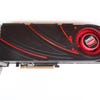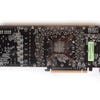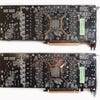Radeon R9 290/290X review
Titan-level performance - at half the price.
Forged with its latest GCN 1.1 architecture at centre, the AMD R9 290X sports a cutting edge Hawaii XT chipset that sets out to better Nvidia's cards - right up to the mighty GTX Titan - for a considerable discount. And unlike the 260X and 270X cards released earlier this year, which were simple rebrands of the existing HD 7790 and 7870 GPUs respectively, this is the company's most forward-thinking entry in the series yet. In amongst support for the pending Mantle API, a unique on-chip TrueAudio sound processing technology makes the cut, plus an ambitious push for gaming at full 4K resolution.
At over £400 this is a wee bit on the dear side for many, but fortunately we now have a cut-down edition of the card in our hands as well: the R9 290, With a mind to achieve a more agreeable circa £300 price-tag, concessions are made to its specs in all the right places - all while still producing competitive results compared to Nvidia's very best.
As part of this eager push for 4K gaming, both the R9 290 and 290X offer up the widest memory buses of any AMD card ever released, counting in at a remarkable 512-bit. This opens the floodgates to some blazing fast access speeds to its 4GB pool of 5GHz RAM, the result being an overall fill-rate of 320GB/s for each card. It's a number that sounds excessive on paper, but any games operating at 2560x1440 and beyond with a lick of MSAA will soon see this statistic put to practical use. For the cheaper 290 variant, cutbacks are made in alternative areas: it takes the 1000MHz maximum core clock of the 290X down to 947MHz, active compute units from 176 to 160, while stream processors get chopped from 2816 to a still respectable count of 2560.
And that's your lot. Remarkably, all other specs remain in place between AMD's two new Hawaii chipset cards - but the biggest difference is in pricing. At the time of writing the R9 290 can be found for as little as £299, as compared to the approximate going rate of £420 for the elder 290X. It also massively undercuts Nvidia rivals such as the GTX 780 and 780 Ti despite bearing competitive specs, and comes in at 40 per cent of the GTX Titan's current price of £760. For AMD's plucky 290 to come even close to these contenders would be a remarkable feat indeed.
With the spec differences being relatively minor given the sharp drop in price, it's a surprise to find the 290X's build quality, connections and approach to cooling go untouched in the transition to the 290. Here we have two dual-slot cards of matching lengths using simple matte plastics for the bulk of their casing. Each is also punctuated with a single 75mm radial fan to direct airflow. Connectivity remains on par too, featuring two DVI-D ports, a single DisplayPort and a HDMI connection lining the end bracket. It must be said that the plastics of both the 290 and 290X do fall short of matching the premium metal finish of Nvidia's 7xx series - and still somehow manage to weigh in at a heftier 0.95kg, as compared to the 0.87kg of Nvidia's GTX 780 Ti.
Weight and dimensions are formidable, and so are the power demands. These AMD cards are driven by 8-pin and 6-pin PCIe power connectors planted up top, where the thermal design power (TDP) amounts to a stated maximum of 250 watts. This falls in line with the specifications of cards like the GTX 780 Ti or GTX Titan, and those intent on embracing this standard of GPU will need to double-check the wattage and connectors of their power supply before jumping in - indeed, we have a feeling that a 250W TDP may be a somewhat optimistic appraisal of the situation.
These high power requirements have a knock-on effect where heat and noise are concerned too. At idle we record an average of 45 degrees Celsius for both cards, but the temperature ramps up dramatically the moment we load up Metro Last Light at 2560x1440 on its highest settings. Pushing the limit at a constant 95 degrees Celsius, the fans kick into full gear to make absolutely sure it stabilises around that number and never veers northward. According to AMD, the card is designed for this temperature - but the sheer heat these cards radiate can't help but give us pause.
In terms of acoustics, the end result is a loud whir that accompanies any gaming session, whereby comparison the noise of the rival 780 Ti stays mild even at its peak temperature of 81 degrees. All this is to say that AMD has produced two supremely hot cards in the 290 and 290X that brush against the limits of safe use - and on average it raises the ambient temperature of our PC case during lengthy gaming spells fairly quickly.
"Despite the tweaks in spec designed to cut the R9 290 down to size, the truth is that its real-life performance level is uncomfortably close to the Radeon R9 290X."
Alternative analysis:
One curious design feature of the 290X is a discrete physical switch to the top edge of each PCB. This offers an option between the so-called Quiet and Uber modes relating to the fan, where speeds are capped at 40 and 55 per cent respectively. During long gaming sessions, the actual performance difference between these two settings is barely distinguishable in practice, however, and the fan's loud acoustic signature remains an issue even on the lower threshold. Raising the fan speed through software to 80 per cent does help keep an overhead in TDP, letting either card run at maximum clock speeds for longer without being throttled downwards. Even so, with the variance being so minor through the hardware switch alone, we press on with our tests on the default Uber mode.
In terms of methodology, we run with AMD drivers updated fully to Catalyst version 13.11, where our test rig features an Intel Core i7-3770k clocked to 4.3GHz, plus 16GB of 1600MHz DDR3 RAM. Our first run-through is with Battlefield 4 on both 1080p and 1440p, where we find anything less than the ultra graphics settings is an absolute cake-walk for either card. Pushing it up to maximum settings enforces a 4x pass of multi-sample AA (MSAA) too that helps to pinpoint the advantages of running with extremely high fill-rates.
And the result? At 1080p there's not much between the two; dips are scarce during indoors gameplay on the Fishing in Baku stage, producing a monotone 60fps during the opening battles. But the biggest in-game drop we see comes during a rigged explosion, taking the 290 down to the 40fps mark, while the 290X crashes to 50fps at the same point only to recover much more swiftly. However, for our synchronised cut-scene tests, featuring an effects-heavy slide down a collapsing building, this lead is marginal at best and only makes for a difference of 2fps in the 290X's favour.
"With the quality settings dialled up, Crysis 3 offers a challenging workout for both top-end Radeons, with the 290X not delivering the extra frame-rates to justify the extra £100 on its price-point."
Alternative analysis:
For gaming at 2560x1440 with 4x MSAA engaged, something has to give though. Right off the bat there's a bigger performance deficit across the board, where it's clear even 320GB/s of memory bandwidth isn't up to the task of smooth 60fps playback. Both cards run Battlefield 4 at 40-50fps, with the more expensive GPU holding a 4fps lead on average during one shootout sequence inside a Shanghai skyscraper. For effects-heavy cut-scenes, though, the lowest reading this time is 18fps for the 290 card - and though the pricier 290X still gives us that same 2fps lead at points, it's far less prolonged at this resolution.
Moving from Frostbite 3 to CryEngine 3, we see an even less stark difference between the two cards on Crysis 3. Set to very high settings with very high textures, plus 2x SMAA running over the top, the game struggles to hold 60fps at 1080p. Rather, it wavers when faced with triggered mines, swathes of tall grass or outdoor skirmishes in the Welcome to the Jungle campaign stage. The on-rails sequence closing this level brings effects-work to the forefront again; on both the 290 and 290X, performance typically falls to 50fps, with no apparent advantage to either card despite a price difference of well over £100.
To see if we can divide the two, then, we run the whole gamut of Crysis 3 tests once more at 2560x1440, where a lock to 30fps is immediately advisable at maxed out settings for the most fluid motion. Sadly, both cards push out practically like-for-like results during cut-scenes, very rarely able to extend above 45fps. By comparison, though peaks and troughs are a feature of both cards' outputs during marshland battles, the 290X carries a marginal - if fleeting - edge here too.
"Does the R9 290 spoil the 290X's market? The biggest difference we could find was in Tomb Raider, where the 290X enjoyed a nine per cent lead over its sibling."
| 1920x1080 | R9 290 | R9 290X | GTX 780 | GTX 780 Ti | GTX Titan |
|---|---|---|---|---|---|
| BioShock Infinite, DX11 Ultra DDOF | 91.0fps | 95.2fps | 98.7fps | 111.5fps | 101.1fps |
| Tomb Raider, Ultra, FXAA | 124.5fps | 135.3fps | 119.2fps | 141.0fps | 130.2fps |
| Metro 2033, Very High, 4x MSAA | 44.1fps | 51.5fps | 47.5fps | 51.8fps | 49.0fps |
| Metro: Last Light, Very High, SSAA | 43.2fps | 46.6fps | 40.7fps | 48.9fps | 43.0fps |
| Hitman: Absolution, Ultra, 8x MSAA | 52.3fps | 55.2fps | 47.0fps | 53.0fps | 49.8fps |
| Sleeping Dogs, Extreme | 64.8fps | 67.8fps | 61.0fps | 72.0fps | 66.5fps |
These Crysis 3 and Battlefield 4 tests show to what extent GPU specs translate to the practical reality of the gameplay experience, where in each case the target refresh is 60Hz. Even so, the traditional approach to benchmark testing, via an in-game option where allowed, gives each card a rigorous stress test that highlights the strengths of the GPUs with no frame-rate cap engaged. Comparing AMD's R9 290, 290X, and also Nvidia's GTX 780 and 780 Ti cards across a range of scripted in-engine tests, we see how far games games are able to rise above the usual performance ceiling.
At 1080p these GPUs aren't being stretched to their fullest extent, but the overwhelming impression is that 60fps is attainable even at the highest setting possible for most games if a cap is implemented. The exceptions, as ever, are 4A Games' compute-heavy Metro 2033 and Last Light games, for which we have super-sample AA and very high tessellation enabled. 43fps is the best we get here on the 290, but amazingly this matches the GTX Titan on likewise settings. This is a trend that continues for Hitman: Absolution, for which the 290's performance draws even with the 780 Ti by brute force of offering higher memory bandwidth to support its 8x MSAA. Equally, the card regularly betters the standard-grade 780 with games like Tomb Raider or BioShock Infinite.
There's no question that the 290X is the better performer, meanwhile, but the question is: by how much? The margin of difference is at its highest with Tomb Raider, with a nine per cent lead over the 290 on average. However, the delta between these two Hawaii cards takes a trivial turn when taking into account the likes of BioShock Infinite, or even Metro Last Light, where a 3fps advantage isn't a perceptible one for the actual in-game experience. The 290X also falls in the same ballpark as the GTX 780 Ti's in terms of overall frame-rates - despite the prices being circa £420 and £550 respectively. That's a considerable leap in expense for just a 4fps lead in Nvidia's favour across only a few games, which, at 1080p, frames both AMD cards as far better value propositions than their Nvidia counterparts.
"Moving up to 2560x1440, the wider memory bus of the dual 290 products becomes more important, putting the GTX 780 under further pressure."
| 2560x1440 | R9 290 | R9 290X | GTX 780 | GTX 780 Ti | GTX Titan |
|---|---|---|---|---|---|
| BioShock Infinite, Very High | 96.8fps | 101.1fps | 91.5fps | 107.8fps | 97.4fps |
| Tomb Raider, High, FXAA | 112.1fps | 118.0fps | 114.6fps | 132.4fps | 119.3fps |
| Metro 2033, High, 4x MSAA | 42.1fps | 40.8fps | 39.5fps | 41.9fps | 41.2fps |
| Metro: Last Light, High, No SSAA | 55.7fps | 59.0fps | 50.0fps | 58.9fps | 53.0fps |
| Hitman: Absolution, High, 8x MSAA/2x MSAA | 38.9fps/ 64.7fps | 41.0fps/ 68.2fps | 32.0fps/ 57.2fps | 35.1fps/ 63.3fps | 34.3fps/ 59.5fps |
| Sleeping Dogs, High | 75.7fps | 78.4fps | 69.4fps | 79.3fps | 73.2fps |
Turning our heads to gaming at 1440p and 4k (3840x2160), we see AMD's 290 truly coming into its own. The sweet spot is almost certainly with gaming at this middle resolution of 1440p, where our test settings drop from those used at 1080p by one notch; from ultra to high. In effect, this creates a wider disparity between the 290 and the likes of the GTX 780, for which the frame-rate gap in Sleeping Dogs is taken to just over 6fps on average. The 290's contention with the GTX Titan is now astoundingly close too - Tomb Raider turning out the only result in the Nvidia card's favour, while the rest of the metrics are a cat's whisker ahead for the AMD 'budget' card.
The spread of results predictably narrows for the 4K tests. Both the AMD 290 and 290X deliver the very best turnout for AMD-optimised titles like Hitman: Absolution, though the GTX 780 Ti remains the consummate leader for most titles when pressed to these extremes. The settings stand at the same levels as our 1440p tests, and the only game which comes out gracefully across the board is Tomb Raider with its borderline 60fps delivery.
Otherwise, we're very much in frame-rate capping territory for the rest of our test roster. Many of the games struggle to hit half the full refresh we had hoped for - though it's impressive indeed to see Metro: Last Light acquit itself at roughly 30fps across all cards. With the PC version of the upcoming Titanfall reported to be "playable" at 4K resolution through just a single GTX Titan card, a similar grade of performance can be expected for all cards in this bracket once it releases, given the similarities in results. That is, if you can track down an affordable monitor as well.
"There's plenty of buzz around 4K PC gaming but the truth is that current top-end GPUs don't provide enough raw horsepower to get the job done at higher settings."
| 3840x2160 (4K) | R9 290 | R9 290X | GTX 780 | GTX 780 Ti | GTX Titan |
|---|---|---|---|---|---|
| BioShock Infinite, Very High | 48.5fps | 50.7fps | 43.1fps | 53.0fps | 48.2fps |
| Tomb Raider, High, FXAA | 56.5fps | 59.4fps | 56.3fps | 67.0fps | 60.2fps |
| Metro 2033, High, 4x MSAA | 19.5fps | 20.7fps | 17.5fps | 20.1fps | 18.2fps |
| Metro: Last Light, High, No SSAA | 29.0fps | 30.4fps | 27.1fps | 31.5fps | 28.2fps |
| Hitman: Absolution, High, 8x MSAA/2x MSAA | 18.6fps/ 34.2fps | 19.5fps/ 35.7fps | 13.7fps/ 28.5fps | 15.5fps/ 33.3fps | 15.3fps/ 31.3fps |
| Sleeping Dogs, High | 35.8fps | 38.4fps | 34.2fps | 41.5fps | 37.4fps |
AMD Radeon R9 290 and 290X: the Digital Foundry verdict
In review, both of AMD's Hawaii-based cards are undeniably hot and noisy by anyone's standards. Running constantly at a near boiling temperature of 95 degrees Celsius, a lot of faith is being placed on the reliability of a single radial fan adjusted to its side. However, the trade-off is evident when considering the value proposition: AMD's R9 290X offers a grade of performance that either matches or exceeds Nvidia's GTX Titan for just over the £400 mark at the time of writing, and puts up a fearsome challenge to the GTX 780 Ti GPU.
That's still a big hole to leave in anyone's wallet though. Hence, we're relieved to see the emergence of the more cost-effective R9 290. This is a card that delivers perceptibly comparable results to its forebear in our Crysis 3 and Battlefield 4 tests, but crucially with the price down-marked even further to £300. The gameplay experience is so close, one might even view the 290 as a spoiler product to the 290X. The value proposition is undeniable: given that the GTX Titan retails at around the £760 point, the 290 is absolutely remarkable for slashing that by over half to achieve largely superior results - especially across our 1440p metrics. It's rare to see a performance-per-pound differential as wild as this between two co-existing cards. Nvidia retains bragging honours with its GTX 780 Ti - which we're in the process of reviewing now - but at £560, that isn't cheap either, and the performance differential against the R9 290 in particular may give you pause.
Overall, it's sobering to admit that 4K gaming is still too much of a stretch for any of these cards at our preferred test settings, but it's still very early days. Even so, we'd recommend 2.5k as standby in the meantime if you're looking for an impactful pixel boost, especially given the wide availability of cheap, high quality panels at this resolution. But back to the question at hand: if you can grin and bear the thermal tightrope-walking of this new AMD GPU, and provided your PC is fully braced for the bold power requirements, the R9 290 comes highly recommended as a shrewd shortcut to the world of high-end GPUs. Slap on a water cooler, or wait for a customised third-party version with a superior heatsink and fan configuration, and we could be looking at an irresistible proposition.












